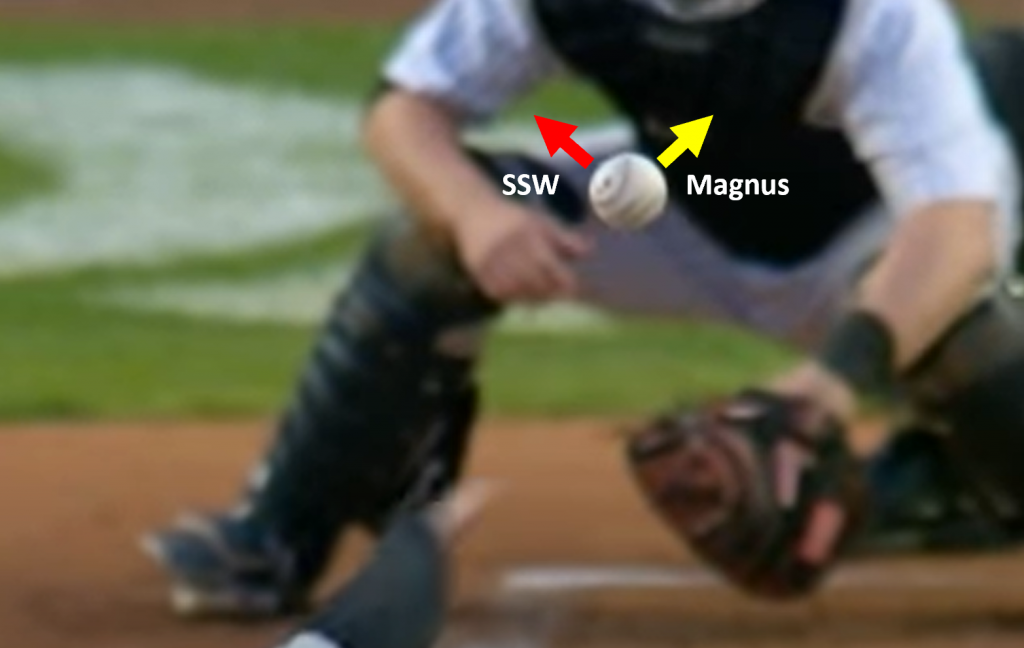
You may have heard of the “Laminar Express” as Trevor Bauer used to call it, or the Seam-Shifted Wake (“SSW”) as it has been called more recently. During the past few years, we have begun to really understand the seam-shifted wake. If you’ve been wondering what it’s all about and how it impacts pitcher’s ball movement, this article is for you, as we cover:
-
- The History
- How to Throw a SSW
- Technology and SSW
- How it’s Observed
- Examples
The History
There is certainly no shortage of studies on the topic of a pitched baseball’s movement pattern. Dr. Alan Nathan from the University of Illinois has published numerous articles and has a website dedicated to the topic called “The Physics of Baseball”. Let’s just say he knows just about everything about the movement on a pitched baseball.
However, on April 29, 2011, during a Blue Jays and New York Yankees game, Yankee pitcher Freddy Garcia threw a split-fingered fastball that was captured by slow-motion video, with enough resolution to observe the spin rate and the tilt axis of the ball. This pitch did not move as expected as Dr. Nathan later explained.
Back in 2006, Dr. Rod Cross from the Department of Physics, University of Sydney, had published an article titled “Aerodynamics in the classroom and at the ballpark” on movement of cricket balls and how stitching could impact airflow around a ball. However, until the Garcia pitch, no one had specifically thought about applying the findings to the movement of a baseball. Perhaps folks assumed it wasn’t possible with a baseball because its stitching with the “figure-eight” seam pattern is a bit more complex than a cricket ball, where the stitching is straight down the middle.
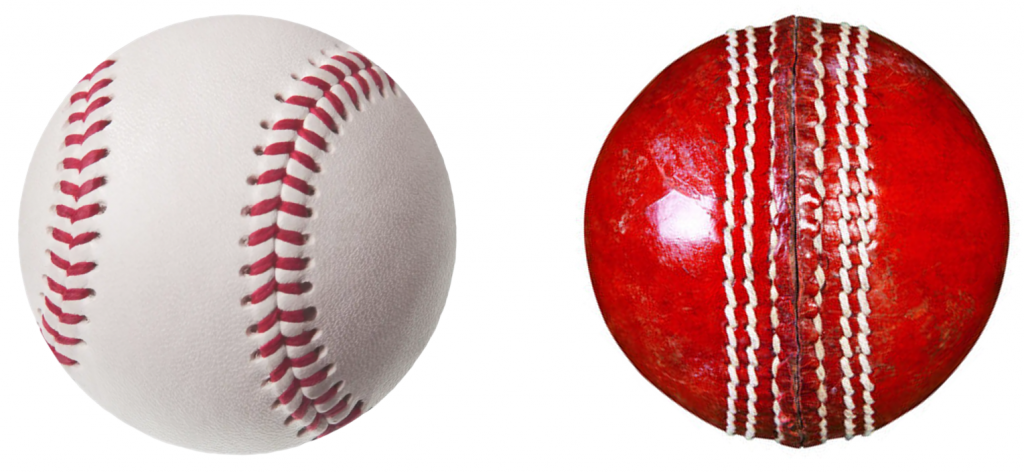
In January 2012, after collaboration with Dr. Nathan on the Freddy Garcia pitch, Dr. Cross posted an excellent video demonstrating what may cause such a movement around a baseball. The video basically demonstrated that if you can create a smooth patch on one side of the ball vs. the other, you can create a different movement than those previously exhibited with Magnus Force.
His video (a must watch) is an excellent summary of how this movement occurs.
However, absent definitive laboratory testing, I believe there was some skepticism on whether you can actually pitch a baseball with figure 8 stitching in a manner that could congregate the stitching more on one side than the other, thereby creating a smooth patch on one side of the baseball.
Since Dr. Cross’ video was posted, additional laboratory testing and extensive research performed by Dr. Barton Smith and his colleagues at Utah State University demonstrated the validity of the additional movement that can be created due to how air flows on different surfaces on the ball during flight (smooth versus rough). His research demonstrated that if a baseball is thrown in manner than creates a “smooth patch” on one side and stitching on a different side during flight, you can create a Seam-Shifted Wake around the baseball. They even gave the movement its current name the “Seam-Shifted Wake”.
This movement is clearly distinct and separate from the Magnus Force and on occasion you can even see it become the dominant force on the ball. Dr. Smith has a website dedicated to this topic which you can access here (image courtesy of baseballaero.com).
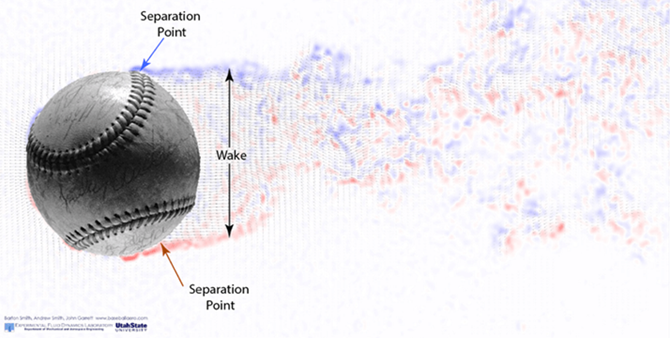
How do you Throw an SSW Pitch?
Now let’s turn to how you actually throw a baseball to create a smooth patch on one side and congregate more of the stitching on a different side to create a Seam-Shifted Wake effect.
Let’s use the 2-seam as an example.
There are a few essential elements to throwing an effective 2-seam fastball using Seam-Shifted Wake. The first element is having two fingers on or close to the two seams of the ball, facing the pitcher. Along with having fingers on the seams, it is important to have a smooth white patch on the side of the ball facing the batter / catcher all time.
This following tweet is from Pitching Ninja, highlighting the grips of pitcher Kyle Hendricks who is known to use Seam-Shifted Wake.
Kyle Hendricks, 87mph Two Seamer (grip/release/spin). Braun's zombie bat attempts revenge on the ball, after the ball broke it. 🧟♀️🧟♂️ pic.twitter.com/LgKTz0VlDK
— Rob Friedman (@PitchingNinja) September 11, 2017
The more the smooth white patch you can create during ball flight, the more the ball uses Seam-Shifted Wake. As explained in the video from Dr. Cross earlier, having one side being smooth and the other having seams makes it so the air movement on each side of the ball is different. This allows the ball, when thrown with backspin, to rotate along an axis perpendicular to the seams, and creates the desired movement.
Today’s Technology
Pitch movement is generally measured with three different technologies, Rapsodo, Trackman and Hawkeye (which is used in MLB stadiums). Here is summary of each and how they read seam-shifted wake:
-
- Certain Rapsodo units can record a seam-shifted wake pitch.
- Trackman does incorporate seam-shifted wake, since reads it based off the movement of the ball.
- Hawkeye can record both tilt axis at release and tilt axis based off the movement of the ball, so we can see the data of a pitch essentially during flight. This allows us to observe which pitcher has benefited the most from Seam-Shifted Wake (more on this below).
How is it observed in Today’s Game?
One of the easiest ways to see the effect of seam shifted wake is by studying the tilt axis. Using MLB’s Hawkeye data on Baseball Savant, we can see the difference between what is listed as observed-movement and spin-based movement, defined by Baseball Savant as follows:
-
- Observed movement – is shown based on plate location and initial velocity vector (actual movement during flight)
- Spin-based movement – is shown over the initial part of the flight towards home (tilt axis at release)
The chart below takes the tilt axes (pitchers view) as given in Baseball Savant and translates it into degrees, starting with 12:00 as 0 degrees. We can see that almost every pitcher has a difference between their observed and spin-based movement. This means that intentional or not, most pitchers are using some degree of Seam-Shifted Wake on their 2-seam fastball impacting their pitch movement.
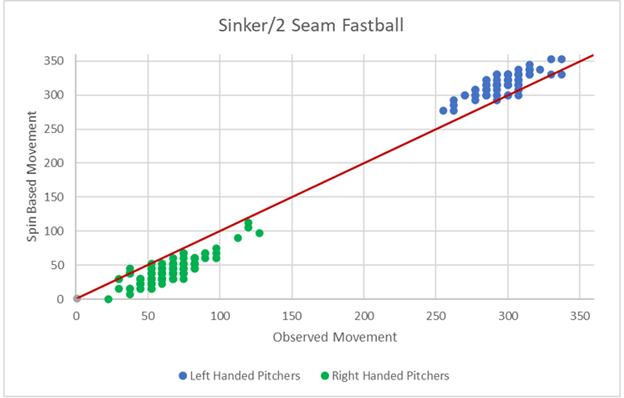
Examples
Another way to look at this is by studying specific pitcher’s charts of tilt axes in the Baseball Savant database. The following are examples for Spencer Turnbull and Kyle Hendricks, two pitchers whose ball movement is commonly known to utilize a Seam-Shifted Wake based.
Example 1 – Spencer Turnbull
Below is Turnbull’s tilt axes from last season. In these pictures there are two colors that I want to focus on, the red color represents his 4-seam fastball, and the orange color represents his sinker. We see that Turnbull’s tilt axes for these two pitches were somewhat similar on the spin-based movement chart (left). However, looking at “observed tilt axes” (on the right) it’s obvious that they have two different movement patterns, with the observed axis showing approximately 1:00 for the fastball and 3:00 for the sinker. The difference is attributed to the Seam-Shifted Wake.
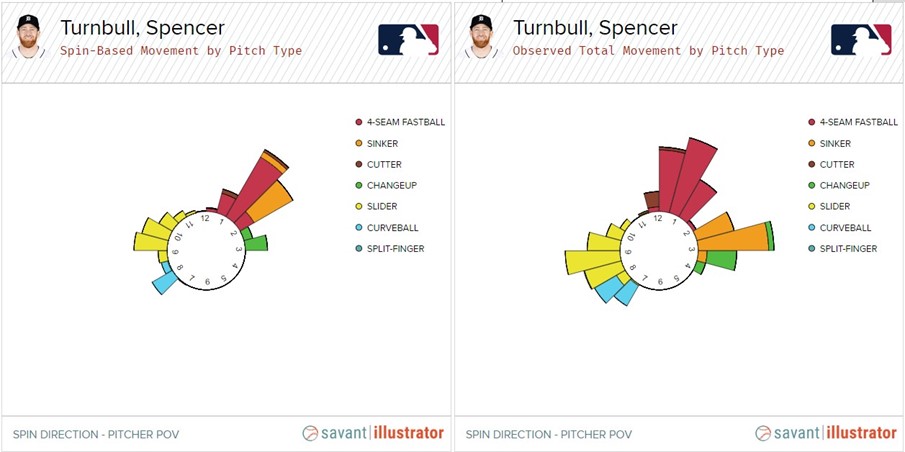
This is a Twitter post by Eno Sarris on Spencer Turnbull from the 2020 season helps illustrate this point.
MY FIRST OVERLAY. Spencer Turnbull’s seam-shifted wake two-seam has nearly the same spin axis as his four-seam, but because of the orientation of the seams, goes in a different direction. More tomorrow: pic.twitter.com/nhvDP0z5QN
— Eno Sarris (@enosarris) January 21, 2021
Example 2 – Kyle Hendricks
Kyle Hendricks is another pitcher commonly known to utilize a Seam-Shifted Wake on his 2-seam. For Hendricks, we can see that Seam-Shifted Wake has the same effect. When looking at the spin-based movement (left), he sits at around 1:00 for both pitches. When we then look at the observed-movement (right), those tilt axes sit at 1:00 for the four-seam fastball and approximately 2:30 for the sinker.
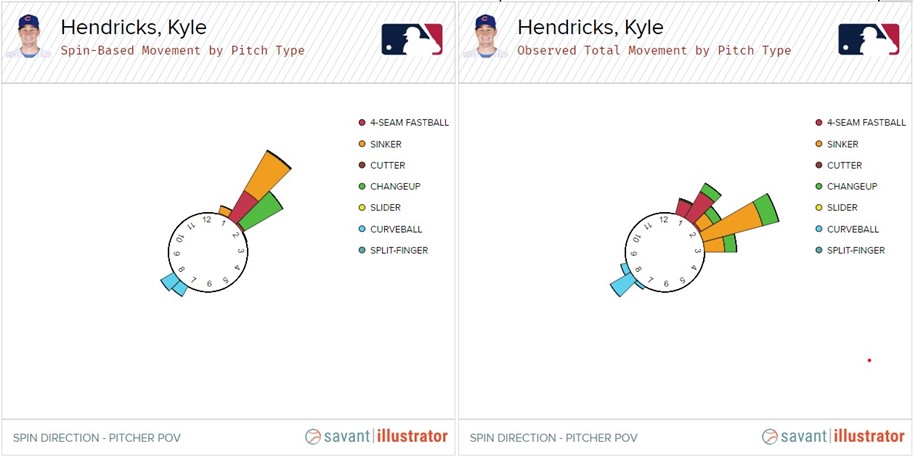

In a similar way to Turnbull, he has created a difference between his 4-Seam and Sinker primarily due the Seam-Shifted Wake. Even though both pitches have similar tilt axes initially (spin-based movement), they end up with completely different movement patterns during flight (observed-based movement).
Seam-Shifted Wake is a relatively new development in pitch design. Now that we better understand this concept, we have begun to see that pitchers who use Seam-Shifted Wake are experiencing great success. As pitchers begin to understand the Seam-Shifted Wake, the number of pitchers who throw it will undoubtedly increase.
By RPP Data Analytics Intern Ken Ruth. He is currently a student at Brigham Young University finishing up his BS degree in computer science. He is also performing data analytics for the BYU Baseball program.
Sources:
-
- The Physics of Baseball (Dr. Alan Nathan)
- Aerodynamics of Baseball (Dr. Barton Smith)
- Hawkeye Data on Baseball Savant
- What is ‘seam-shifted wake’ and which pitchers benefit most from it? (The Athletic)
- Aerodynamics in the classroom and at the ball park (Dr. Rod Cross)
- Dissecting a Mystery Pitch (The Hardball Times)
- What is ‘seam-shifted wake’ and why is it important to Kyle Hendricks and the Cubs? (The Athletic)
Enter your email below to be added to our email list!
